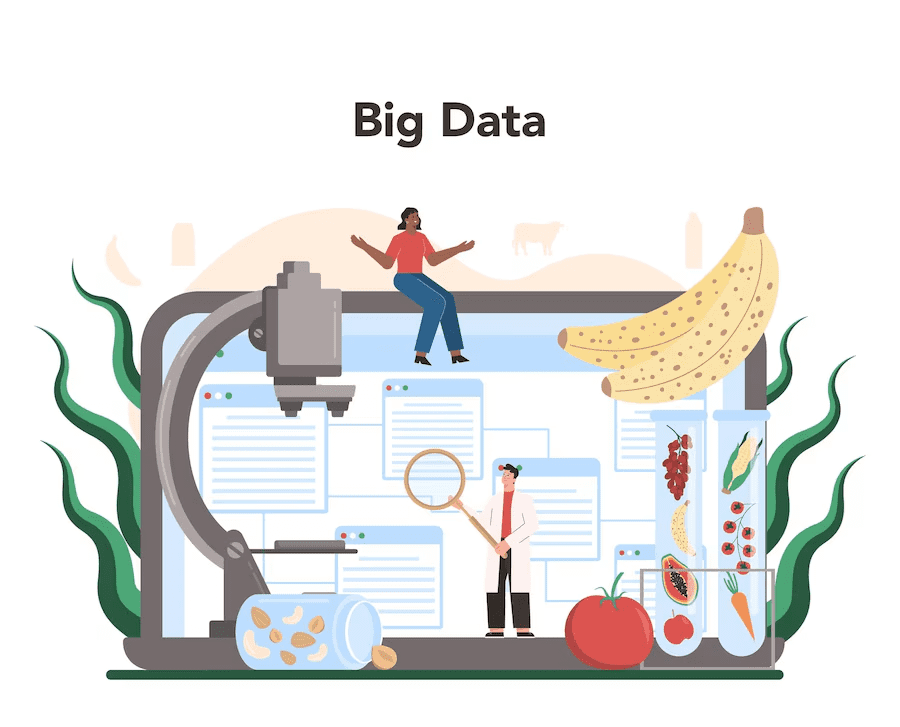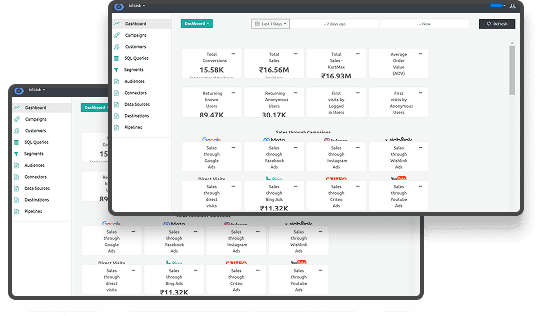TLDR
- Data ingestion is the process of collecting and integrating data into a centralized system for analysis.
- Key types of data ingestion include batch, real-time, and micro-batching, each suited for different use cases.
- Common data ingestion techniques include API-based, file-based, stream-based, and agent-based methods.
- Effective data ingestion helps businesses make faster, informed decisions and ensures accurate data processing.
- Challenges in data ingestion involve maintaining data quality, managing scalability, and integrating various data sources.
Are your data systems keeping up with the demands of modern business?
In a landscape where data is growing exponentially, traditional methods of handling information are often insufficient. For instance, the global daily data generation surpassed 402 million terabytes, highlighting the immense volume organizations must manage. This surge necessitates efficient data ingestion strategies to ensure timely and accurate decision-making.
Data ingestion, the process of collecting and importing data from various sources into a centralized system, is foundational to modern data architectures. Without a streamlined ingestion process, businesses risk facing challenges such as delayed insights, inconsistent data quality, and increased operational costs. Moreover, as organizations expand their digital footprints, the complexity of integrating diverse data sources intensifies.
This blog delves into the intricacies of data ingestion, exploring its process, tools, and types to help you build a robust data strategy.
What Is Data Ingestion?
Data ingestion is the process of collecting, importing, and integrating data from multiple sources into a centralized system, such as a data warehouse or a customer data platform (CDP). This process ensures that raw data from various channels, websites, mobile apps, CRM platforms, and marketing tools is consolidated in one place for analysis and informed decision-making.
With this information, let's examine the major components.
Key Components of Data Ingestion
Data ingestion involves more than simply collecting information; it requires identifying the source of the data, preparing it for analysis, and storing it securely. These core components ensure that incoming data is clean, structured, and accessible for decision-making.
- Source Identification: Data can originate from various platforms, including social media, e-commerce sites, and ad campaigns.
- Transformation: Converting raw data into structured formats for easy analysis.
- Storage: Centralizing data in a location that is accessible for reporting and analytics.
By integrating first-party data and reducing reliance on third-party cookies, businesses can better comply with privacy regulations, such as GDPR and CCPA, while maintaining precise targeting capabilities.
Vineeth Rajan has explained the importance of data ingestion in his LinkedIn post as
“Data ingestion can help businesses to break down these silos and combine data from different sources into a single, unified view. This can provide businesses with a number of benefits,....”
Read more about the importance of first-party data strategies here.
Now that we understand what data ingestion entails let’s examine the various methods businesses can employ.
Types of Data Ingestion
To build a robust data strategy, it’s essential to understand the different ways data can be ingested into your systems. Each method offers distinct benefits based on your organization’s scale, geographic reach, use case, and the immediacy of insights needed. The three primary types of data ingestion are batch ingestion, real-time ingestion, and micro-batching.
1 Batch Ingestion
Batch ingestion involves importing large volumes of data at scheduled intervals, such as hourly, daily, or weekly, to facilitate high-throughput processing. This method is ideal when immediate access to data isn’t critical.
- Key Advantages:
- Resource-Efficient: Conserves compute and network resources by grouping data.
- Cost-Effective at Scale: Suitable for large enterprises operating across multiple regions that can afford delayed data processing in exchange for lower infrastructure costs.
- Ideal for Historical Analysis:
- CRM exports, sales reports, and email campaign data often fall under this method.
- Widely used in sectors like finance, healthcare, and logistics.
- Limitations:
- Delayed insight generation makes it less suitable for real-time personalization or fraud detection.
- Requires scheduling tools (e.g., Apache NiFi, Talend) and job orchestration systems, such as Airflow.
2 Real-Time Ingestion
Real-time data ingestion captures data as it's generated, making it ideal for use cases that demand instant visibility and response.
- Key Use Cases:
- User Interaction Monitoring: Track clicks, scrolls, form submissions, and session behaviors across websites and mobile apps.
- Ad Campaign Optimization: Automatically adjust spend and targeting based on live conversion signals.
- IoT and Geo-Based Applications:
- For connected devices in smart cities or remote monitoring setups, real-time ingestion ensures immediate anomaly detection.
- Key Tools:
- Apache Kafka, AWS Kinesis, and Google Cloud Pub/Sub.
- Platforms like Ingest Labs use server-side tagging to support privacy-compliant, real-time collection.
- Challenges:
- Higher infrastructure costs due to the need for always-on data pipelines.
- Requires robust error handling and latency management.
3 Micro-Batching
Micro-batching is a hybrid model that combines the best of batch and real-time processing by collecting data in smaller, more frequent intervals.
- Why It’s Useful:
- Balances Latency and Cost: Offers near-real-time insights while consuming fewer resources than full real-time systems.
- Best for Regional or Multi-Location Deployments:
- When operating in multiple geographies, micro-batching enables local ingestion hubs to periodically forward processed data to a central data warehouse.
- Implementation Patterns:
- Often used with Spark Streaming or Flink in time-windowed processing jobs.
- Ideal for applications needing rolling averages or time-series dashboards (e.g., eCommerce performance, in-app activity spikes).
- Benefits Over Traditional Methods:
- Reduces the need for large processing jobs while maintaining responsiveness.
- Scales well with multi-region cloud setups.
This knowledge enables us to understand data ingestion techniques, which in turn allow us to efficiently collect, process, and analyze large volumes of data for various applications.
Data Ingestion Techniques
Data ingestion techniques define how data is collected from various sources and moved into centralized systems for analysis. These techniques are selected based on factors such as data freshness, complexity, volume, and integration requirements. Below is an in-depth examination of the most widely used methods and their respective applications.
1 API-Based Ingestion
APIs enable direct, programmatic access to data from external platforms such as CRMs, advertising tools, eCommerce systems, and analytics platforms. This method is highly structured and is used when continuous or on-demand data retrieval is needed.
- Often used to ingest data from platforms like Salesforce, Stripe, Facebook Ads, or Google Analytics.
- Supports structured data formats (JSON, XML)
- Scales well for applications needing periodic syncs or live updates
- Use Ingest IQ for connecting to APIs, orchestrating the collection, and centralizing data from multiple SaaS sources.
This technique is ideal when you need reliable, secure access to current data from SaaS platforms that expose data through endpoints.
2 File-Based Ingestion
In this method, data is collected from files stored in local directories, FTP servers, or cloud storage services like Amazon S3 and Google Cloud Storage. These files may include CSVs, JSON logs, XML exports, or Excel spreadsheets.
- Best suited for batch ingestion of static or historical data
- Common in legacy systems or internal tools that don’t expose APIs
- Often paired with scheduled jobs or cron-based workflows
It’s a reliable approach for processing extensive data sets on a fixed schedule, particularly when real-time speed is not a priority.
3 Change Data Capture (CDC)
CDC captures real-time changes, such as inserts, updates, or deletes, from source databases and replicates them downstream without scanning the full dataset.
- Reduces data volume by transferring only changed records
- Maintains sync between operational databases and analytics environments
- Familiar with databases like MySQL, PostgreSQL, and SQL Server.
- Event IQ is ideal for tracking and analyzing CDC events as custom events for deeper behavioral analytics.
This technique is crucial for applications that require the immediate reflection of transactional data, such as order systems or customer account updates, while maintaining system performance.
4 Stream-Based Ingestion
Stream ingestion captures continuous data flows in real-time using message brokers or event buses, such as Apache Kafka, Amazon Kinesis, or Google Pub/Sub. It supports high-frequency data events such as user interactions, IoT signals, or telemetry.
- Processes data with low latency
- Supports event-by-event decision-making and automation
- Essential for fraud detection, live dashboards, and behavioral analytics
This approach is ideal when immediacy is critical, like capturing user activity on a website or handling transactions from connected devices.
5 Micro-Batching
Micro-batching is a hybrid approach that collects small batches of data at frequent intervals, often every few seconds or minutes. It balances the need for timeliness with improved resource management compared to pure streaming.
- Useful for near-real-time data pipelines
- Reduces system strain while still offering quick insights
- Common in platforms using Spark Streaming or Flink
This technique works well for operational reporting, performance monitoring, and cases where second-by-second accuracy isn’t necessary, but hour-long delays are unacceptable.
6 Agent-Based Ingestion
Agent-based ingestion utilizes lightweight software components, called agents, installed on source systems to monitor and forward data in real-time.
- Frequently used for log aggregation, infrastructure monitoring, and observability.
- Supports secure, persistent transmission from distributed systems
- Tools include Ingest Labs.
This method excels in DevOps environments where visibility into system behavior or application performance is essential across regions or cloud instances.
7 Server-Side Tagging
Server-side tagging shifts data collection logic from the browser to the server, allowing organizations to collect data while improving website performance and complying with privacy regulations.
- Reduces client-side script load and improves page speed
- Protects data from ad blockers and browser limitations
- Enables compliant, first-party data tracking (e.g., Facebook CAPI, TikTok Events API).
- Ingest IQ and Tag Manager can deploy and manage agents for collecting log and telemetry data.
This technique is especially relevant for marketing and analytics teams working in a cookieless, privacy-first environment.
As we move forward, let’s examine the tools that can help automate and streamline your data ingestion process.
Data Ingestion Tools and Automation
Data ingestion tools facilitate the collection and processing of data from various sources. Some popular tools and solutions include cloud platforms, databases, and specialized software that automate various aspects of the process. These tools allow you to ingest data with minimal manual effort, improving efficiency.
Ingest Labs as a Data Ingestion Platform
- Ingest Labs provides a privacy-focused, centralized platform for ingesting visitor and event data from websites, mobile apps, and other digital properties.
- Ingest IQ is the core engine, offering server-side data ingestion, automated tag management, and real-time data streaming to downstream systems2.
- The Web Tagging and Mobile App Tagging modules enable seamless, no-code integration of tracking tags and SDKs, automating the collection of behavioral data across digital channels.
- Data Streaming enables real-time event forwarding to data lakes, CDPs, or analytics environments, supporting both batch and streaming ingestion models.
Here’s how tag error monitoring can help maintain data quality in real-time.
It’s also essential to differentiate data ingestion from similar processes, such as ETL, to use them effectively.
Data Ingestion vs ETL
It’s easy to get confused between data ingestion and ETL (Extract, Transform, Load). While both deal with moving data, they serve slightly different purposes.
- Data Ingestion is about bringing data into your system without altering it. It’s the first step in the data processing process.
- ETL goes a step further by transforming the data and loading it into a specific data storage or data warehouse.
To understand how these two processes work together, refer to our guide on server-side tagging.
Recognizing its role is vital, but what are the real benefits of data ingestion for your business?
Benefits of Data Ingestion
The benefits of efficient data ingestion are not to be overstated. Here are a few key advantages:
- Improved Decision-Making: With clean, consolidated data, you can make more informed and better decisions.
- Faster Insights: The faster you collect data, the quicker you can analyze and act on it.
- Compliance: Tools like Ingest Labs help ensure that your data collection processes align with regulations such as GDPR and CCPA, allowing businesses to maintain customer trust.
- Better Performance: Optimized data ingestion improves the performance of your websites and campaigns.
- Personalized Experiences: Using first-party data, businesses can offer more tailored marketing to their customers. Learn how to craft personalized experiences with first-party data.
For example, if you want to optimize your conversion funnels in digital marketing, streamlined data ingestion ensures you’re gathering the right data to improve your campaigns. Explore how to optimize conversion funnels.
While it’s powerful, data ingestion does come with its own set of challenges that need to be addressed.
Challenges in Data Ingestion
While data ingestion is crucial, it’s not without its challenges. Some common obstacles include:
- Data Quality: Ingesting large volumes of data can sometimes lead to inconsistencies.
- Scalability: As your business grows, scaling the ingestion process can be a headache.
- Integration: Integrating with multiple platforms or data sources can be difficult.
Addressing these challenges requires robust tools and strategies. Understanding the impact of a cookieless future can help you navigate the challenges of managing data from diverse sources while staying compliant with privacy laws.
Best Practices for Data Ingestion
While data ingestion can unlock valuable insights, poor execution often results in bottlenecks, broken dashboards, and unreliable reporting. Adopting clear best practices reduces these risks, enabling teams to ingest and act on data with speed and confidence.
1 Automate Ingestion to Minimize Manual Errors
Manual ingestion processes are resource-heavy and prone to inconsistency, especially when managing high volumes from disparate sources. Automated data ingestion tools can handle repeatable tasks through event-based triggers, reducing human error and accelerating processing. This not only increases scalability across teams but also ensures that insights reach decision-makers faster.
2 Establish Data SLAs Based on Real Business Needs
Before deciding on batch vs. streaming ingestion, clarify expectations with data consumers. What data do they need, how fresh should it be, and what happens if it's late or incomplete? Documenting data SLAs ensures alignment between producers and consumers and creates accountability when SLAs are missed.
3 Keep Operational and Analytical Systems Separate
Tightly coupling analytics systems with operational databases like Postgres can lead to cascading failures. Isolating ingestion targets from transactional systems protects both environments and allows ingestion pipelines to scale independently from application logic.
4 Use Targeted Data Quality Checks at Ingest
While it’s tempting to check for every anomaly during ingestion, this approach isn’t scalable. Instead, identify critical pipelines that need strict thresholds and implement data circuit breakers for those only. These checks prevent insufficient data from polluting downstream analytics while preserving accessibility where precision is less critical.
5 Invest in Data Observability
Instead of blocking ingestion at every potential fault, use observability tools to monitor freshness, volume, and schema drift. This approach allows teams to detect and respond to anomalies before they affect business users without unnecessarily halting ingestion flows.
Ingest Labs’ Ingest IQ suite automates data ingestion across web and mobile, integrates real-time monitoring and alerting, and provides live debugging to minimize manual errors and ensure data quality. Its Tag Monitoring & Alerts and Data Streaming features enable observability, targeted validation, and seamless integration with existing tools, all through a privacy-first, no-code platform that supports compliance and operational separation.
This is where Ingest Labs steps in to redefine how data ingestion supports your marketing efforts.
Final Thoughts
Data ingestion is more than just a technical process. It’s a vital tool for modern businesses. By collecting and organizing data efficiently, you can gain valuable insights, ensure compliance with privacy regulations, and improve your overall marketing strategies.
With the right approach, tools, and best practices, data ingestion can help you stay ahead in today’s fast-changing, data-driven world. Ingest Labs provides the expertise and solutions you need to maximize the value of your data, ensuring it works for your business, not against it.
Ready to take control of your data and transform your marketing? Contact Ingest Labs today and discover how we can help you succeed.
FAQ
1. What attribution model does GA4 use?
GA4 uses data-driven attribution (DDA) by default, which distributes conversion credit based on how each touchpoint impacts the outcome using machine learning and your actual user data.
2. Can you explain the concept of attribution modeling and how it is used in marketing analytics?
Attribution modeling is a way to assign credit to different marketing touchpoints that lead to a conversion. It helps you understand which ads or channels contribute the most to user actions like purchases or sign-ups.
3. What's the difference between single-touch and multi-touch attribution models?
Single-touch models credit only one touchpoint (first or last), while multi-touch models spread credit across multiple interactions a user has before converting.
4. What is the difference between MMM and multi-touch attribution?
Marketing Mix Modeling (MMM) analyzes channel performance using historical, aggregate data. Multi-touch attribution (MTA) focuses on user-level data to track specific actions across the customer journey.
5. What are the two significant models of attribution?
The two most commonly used are:
- Last Click Attribution, which gives full credit to the final interaction before conversion.
Data-Driven Attribution, which uses machine learning to credit each touchpoint based on its influence.






